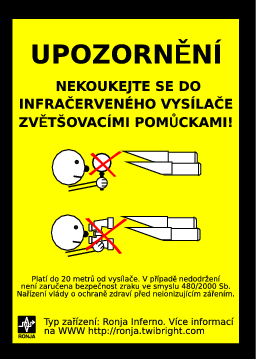

 |
| Postscript / PDF / EPS / BIG png / SVG (Inkscape) |
![Gallery[4f9]](http://images.twibright.com/tns/lvl0/4f9.jpg) In vast majority of world's countries it is not necessary
to undergo any formalities to legally operate LED-driven visible optical
transmitting system. The divergence angle virtually eliminates any possibility
of interference with any other optical device or neighbourhood annoyance with
the distinctively visible light beam and thus no legal issues should arise
during the operation.
In vast majority of world's countries it is not necessary
to undergo any formalities to legally operate LED-driven visible optical
transmitting system. The divergence angle virtually eliminates any possibility
of interference with any other optical device or neighbourhood annoyance with
the distinctively visible light beam and thus no legal issues should arise
during the operation.
![Gallery[301]](http://images.twibright.com/tns/lvl0/301.jpg) The emitted beam poses no risk to birds and any other
animals. This condition is fully preserved even in condition of device failure
of any kind and/or unauthorized manipulation.
The emitted beam poses no risk to birds and any other
animals. This condition is fully preserved even in condition of device failure
of any kind and/or unauthorized manipulation.
![Gallery[32d]](http://images.twibright.com/tns/lvl0/32d.jpg) The device poses no electric shock hazard to humans when mounted in publicly
accessible places as it contains voltages that are not lethal even under
severe atmospherical conditions, unauthorized tampering, and any possible
device failure.
The device poses no electric shock hazard to humans when mounted in publicly
accessible places as it contains voltages that are not lethal even under
severe atmospherical conditions, unauthorized tampering, and any possible
device failure.